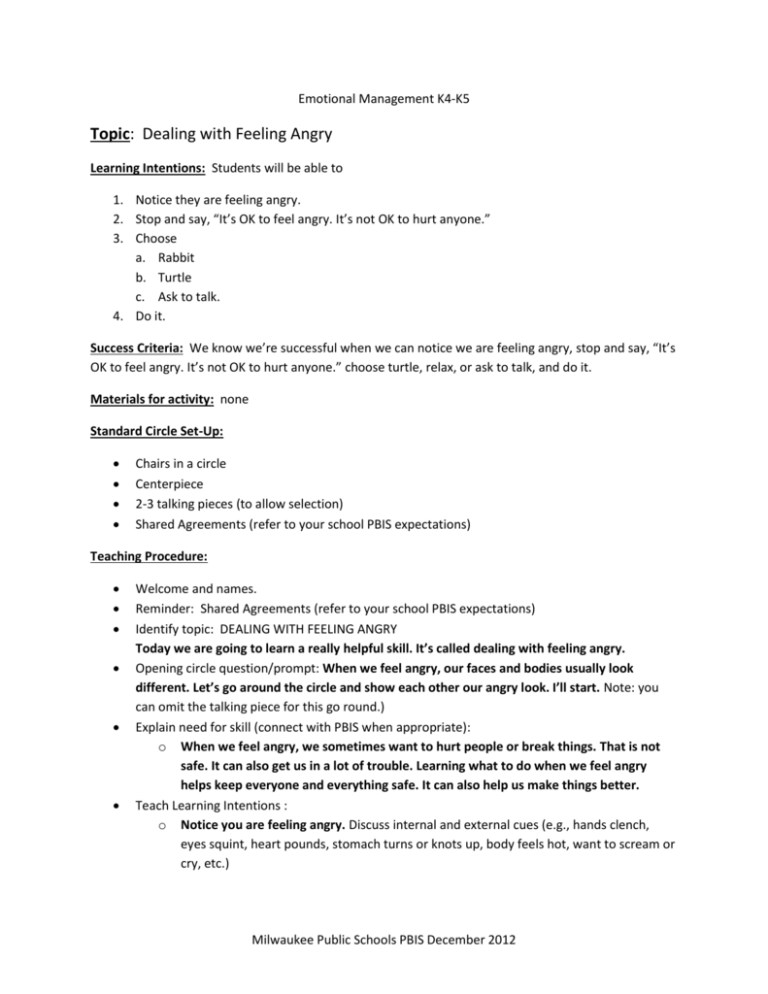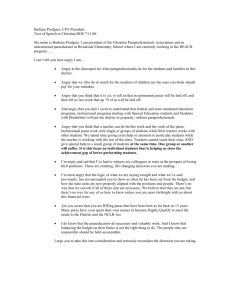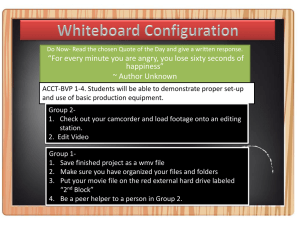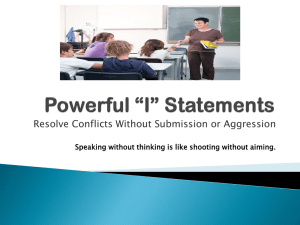Dealing with Feeling Angry
advertisement

Emotional Management K4-K5 Topic: Dealing with Feeling Angry Learning Intentions: Students will be able to 1. Notice they are feeling angry. 2. Stop and say, “It’s OK to feel angry. It’s not OK to hurt anyone.” 3. Choose a. Rabbit b. Turtle c. Ask to talk. 4. Do it. Success Criteria: We know we’re successful when we can notice we are feeling angry, stop and say, “It’s OK to feel angry. It’s not OK to hurt anyone.” choose turtle, relax, or ask to talk, and do it. Materials for activity: none Standard Circle Set-Up: Chairs in a circle Centerpiece 2-3 talking pieces (to allow selection) Shared Agreements (refer to your school PBIS expectations) Teaching Procedure: Welcome and names. Reminder: Shared Agreements (refer to your school PBIS expectations) Identify topic: DEALING WITH FEELING ANGRY Today we are going to learn a really helpful skill. It’s called dealing with feeling angry. Opening circle question/prompt: When we feel angry, our faces and bodies usually look different. Let’s go around the circle and show each other our angry look. I’ll start. Note: you can omit the talking piece for this go round.) Explain need for skill (connect with PBIS when appropriate): o When we feel angry, we sometimes want to hurt people or break things. That is not safe. It can also get us in a lot of trouble. Learning what to do when we feel angry helps keep everyone and everything safe. It can also help us make things better. Teach Learning Intentions : o Notice you are feeling angry. Discuss internal and external cues (e.g., hands clench, eyes squint, heart pounds, stomach turns or knots up, body feels hot, want to scream or cry, etc.) Milwaukee Public Schools PBIS December 2012 o o o o Stop and say to yourself, “It’s OK to feel angry. It’s not OK to hurt anyone.” Explain that all people feel angry sometimes. Feeling angry is OK. Hurting people when we are feeling angry is not OK. Talk about the possible negative consequences of acting out angry feelings in a hurting way (e.g., hitting the person or saying something mean). Also explain that stopping and talking to ourselves gives us time to think of safe choices. Choose Rabbit. Explain that rabbits are fast and have strong legs. Share ideas of fast, strong activities* like running around the playground, jumping up and down, dancing, pretending to squish all the juice out of an orange with our hands and then letting it drop to the ground. Explain that doing fast, strong things that don’t hurt anyone can help the angry feelings come out of us. *Note: Suggest actions that actually release anger, not actions like screaming or punching a pillow. These kinds of actions have been found to churn up more anger because they are actually expressions of anger. Turtle. Explain that turtles have shells they can curl up into. Turtle shells are kind of like secret clubhouses. When we curl up in our turtle shell, we can’t see the person with whom we are angry. Once we’re in our shell, we can do quiet things that help our angry feelings come out. Share ideas of quiet, slow things like controlled, conscious breathing;* sending breath to tight body parts; filling breath with favorite colors, aromas, sounds, light, warmth; visualizing happy places; counting slowly; stretching; imagining you’re inside a bubble and no one can come in to bother you. Coloring might be another option. *Note: Slow, calm breaths are important. Deep gulping breaths can rev students up even more or lead to hyperventilating. Some people recommend breathing in through your nose and out through your mouth. Others recommend breathing in and out through your nose. The main thing to remember is not to inhale through your mouth. Ask to talk. Talking to people about our angry feelings is another way to help the angry feelings come out. It can also help us figure out how to solve the problem we got angry about. Discuss people children can talk to. Do it. Success Criteria: We know we are successful when we can notice we are feeling angry, stop and say to ourselves, “It’s OK to feel angry. It’s not OK to hurt anyone.”, choose rabbit, turtle, or ask to talk, and do it. A. Model examples and non examples of dealing with feeling mad: a. Let’s see how this could work. Let’s pretend that after recess I’m standing in line at the bubbler waiting my turn to get a drink. I’m really thirsty! Another girl in my class runs up to the line and jumps in front of me. I can tell I’m feeling angry because my eyes start to squint, my hands turn into fists, I want to scream and push the girl out of the line. So I stop and tell myself, “It’s OK to feel angry. It’s not OK to hurt anyone.” I decide to be a turtle and go into my shell. Inside my shell I Milwaukee Public Schools PBIS December 2012 pretend I’m breathing pretty sparkles all around me. I breathe very slowly. Pretty soon I start to feel calm. I wait my turn and get a drink. The cold water is great! I go back to my class and sit at my table. b. Ask students: How could you tell I was dealing with feeling angry in a safe way? What steps did you hear and see me use? Make sure they mention all the steps. c. Let’s try another story. This time I’m not going to use all the safe steps for cooling off. See if you can notice which steps I miss. Let’s pretend that we are on the playground at recess. It’s my turn to have the bouncy ball and I’m playing with my friend. When my friend kicks the ball, it goes a long way. I run to get it but another boy grabs the ball before I get to it. He won’t give it back to me. I notice I’m feeling angry because my hands make fists and my heart beats fast and I feel energy all over my body. I want to kick the boy! I run up to the playground teacher and yell, “That boy took my ball!” d. Ask students: Which steps did you hear and see me use this time? Which ones did I miss or mess up on? How could I have done better? B. Provide students with examples and non examples of dealing with feeling mad such as: a. At recess, you are racing with your friend and you trip and fall down. Your hands get scraped up and start to bleed a little. They really hurt! Tears start coming out of your eyes. Your friend sees your tears and calls you a baby. You notice you are feeling angry because your face is scrunching up and you want to scream, “I am NOT a baby! YOU’RE a baby!” You stop and tell yourself “It’s OK to feel angry. It’s not OK to hurt anyone.” You decide to be a rabbit and you run away from your friend and run around the playground until you feel better. Then you ask the playground teacher if you can go to the nurse. b. The lunch line teacher tells you to go to the end of the line because you are talking. But really you weren’t talking. It was the person behind you. You stomp to the back of the line and yell, “That’s not fair!” c. You want to work on the fire truck puzzle because it’s your favorite. Someone else is using it and they tell you that you can’t have a turn. You notice that you are angry because your stomach starts feeling funny and your hands are starting to make fists. You want to grab the puzzle. You say to yourself, “It’s OK to be angry. It’s not OK to hurt anyone.” Then you run to the coat room and cry. C. Practice/Role Play 3x: Have each student describe a situation in which they might want to use this skill. Role play these situations - or use the scenarios above. (For a detailed model of how to use role play and give feedback, see Skillstreaming.) Milwaukee Public Schools PBIS December 2012 Activity to practice skill: Rabbit/Turtle/Ask After students have practiced some ways to deal with anger by being a rabbit, a turtle, or asking to talk, let them take turns modeling one choice and have the other students call out “Rabbit”, “Turtle”, or “Ask” depending on which choice the student is modeling. Closing Circle Questions: Which choice do you like the best – rabbit, turtle, or ask to talk? When can you practice this choice? Milwaukee Public Schools PBIS December 2012







